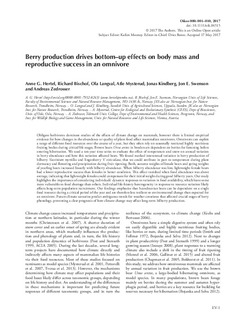Berry production drives bottom – up effects on body mass and reproductive success in an omnivore
Hertel, Anne Gabriela; Bischof, Richard; Langval, Ola; Mysterud, Atle; Kindberg, Jonas; Swenson, Jon; Zedrosser, Andreas
Journal article, Peer reviewed
Published version

Åpne
Permanent lenke
http://hdl.handle.net/11250/2447322Utgivelsesdato
2017Metadata
Vis full innførselSamlinger
- Publikasjoner fra CRIStin - NINA [2364]
- Scientific publications [1392]
Originalversjon
10.1111/oik.04515Sammendrag
Obligate herbivores dominate studies of the eff ects of climate change on mammals, however there is limited empirical evidence for how changes in the abundance or quality of plant food aff ect mammalian omnivores. Omnivores can exploit a range of diff erent food resources over the course of a year, but they often rely on seasonally restricted highly nutritious fruiting bodies during critical life stages. Brown bears Ursus arctos in Sweden are dependent on berries for fattening before entering hibernation. We used a ten-year time series to evaluate the eff ect of temperature and snow on annual variation in berry abundance and how this variation aff ected bears. We found marked interannual variation in berry production of bilberry Vaccinium myrtillus and lingonberry V. vitis-idaea , that we could attribute in part to temperature during plant dormancy and flowering and precipitation during fruit ripening. Both, autumn weights of female bears and spring weights of yearling bears increased linearly with bilberry abundance. When bilberry abundance was low, lightweight female bears had a lower reproductive success than females in better condition. Th is eff ect vanished when food abundance was above average, indicating that lightweight females could compensate for their initial weight during good bilberry years. Our study highlights the importance of considering individuals ’ dynamic responses to variation in food availability, which leave some more vulnerable to food shortage than others. Individual life-history heterogeneity in response to resource variation likely aff ects long-term population recruitment. Our fi ndings emphasize that Scandinavian bears can be dependent on a single food resource during a critical period of the year and are therefore less resilient to environmental change than expected for an omnivore. Future climate scenarios predict ambiguous trends for weather covariates that aff ected crucial stages of berry phenology, preventing a clear prognosis of how climate change may aff ect long-term bilberry production.
